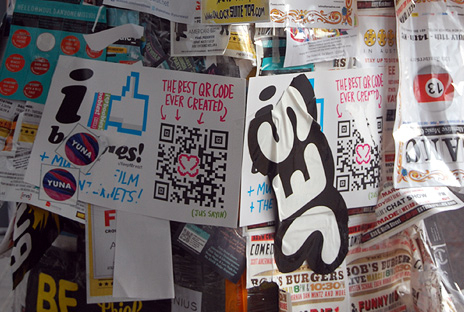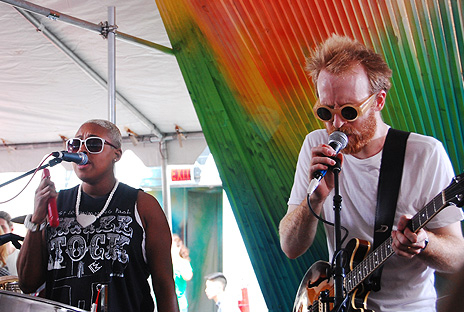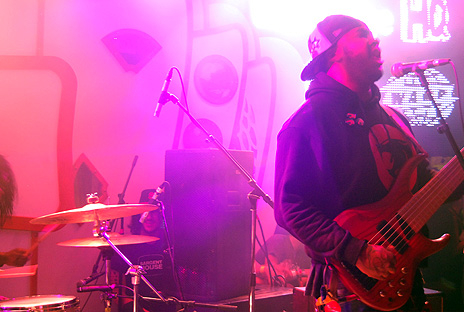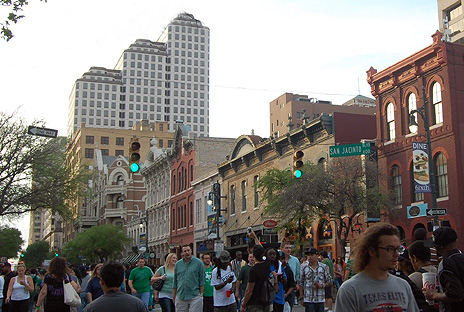- This year's SXSW played host to 2,000 performing groups, 50 different countries and 90 stages. In a musical climate where the same kinds of festivals, with the same kind of lineups in the same kind of festival sites dominate—the massive urban musical SXSW is refreshing. This conference/festival hybrid has been running strong for over 25 years in Austin, Texas, while maintaining the mission of showcasing new, quality music of any genre imaginable, and from artists predominantly in their infancy and others that have made it to the solid middle ground of successes. With this much going on, the chances of gaining a bit of a headache and some anxiety may be high. But for those of you who enjoy choices, this sonic smorgasbord is appetizing.
 There are two sides of SXSW, the official festival and the unofficial festival. This unofficial side was born predominantly from two factors; the credential fees—that can be upwards of $595 for a badge and $175 for a wristband—and the massive amount of artists, sponsors and industry eyes in one area. Any festival or conference of this nature usually experiences pains in controlling this expansion into the black market realm, throughout the years, though, they have developed a kind of symbiotic relationship.
The unofficial side lies mainly across the highway, away from the bustling venue row of 6th street. This area has become the home to these SXSW side festivals. Here lies the Fader Fort, a large tent compound set-up for days worth of entertainment and all the buzz acts you would see at official showcases, MWT (Mess With Texas)—a three day mini-daytime festival led by Los Angeles based promoters FYF, events at clubs like the Shangri-La and Cheer up Charlie's. Even Boiler Room posted up shop at a home for their live broadcasts. While it may be a bit more rugged—standing in grass lots and facing the Texas heat instead of inside a nightclub—it's also free.
There are two sides of SXSW, the official festival and the unofficial festival. This unofficial side was born predominantly from two factors; the credential fees—that can be upwards of $595 for a badge and $175 for a wristband—and the massive amount of artists, sponsors and industry eyes in one area. Any festival or conference of this nature usually experiences pains in controlling this expansion into the black market realm, throughout the years, though, they have developed a kind of symbiotic relationship.
The unofficial side lies mainly across the highway, away from the bustling venue row of 6th street. This area has become the home to these SXSW side festivals. Here lies the Fader Fort, a large tent compound set-up for days worth of entertainment and all the buzz acts you would see at official showcases, MWT (Mess With Texas)—a three day mini-daytime festival led by Los Angeles based promoters FYF, events at clubs like the Shangri-La and Cheer up Charlie's. Even Boiler Room posted up shop at a home for their live broadcasts. While it may be a bit more rugged—standing in grass lots and facing the Texas heat instead of inside a nightclub—it's also free.
 The most distinct feature about that official festival is the existence of showcases. A "showcase," in SXSW speak, means a show booked by the festival, with talent selected by the festival and in the evening of one of the music days. This is why those fifty countries mentioned make it out. Historically, bands have "made it" based on these shows, partially because those that are there all have credentials to get in, and a badge usually means "industry." They could be sponsored by an agency like The Windish Agency at the ND with Tanlines, or a media outlet like Pitchfork at the Mohawk with Sun Araw and Matthew Dear. Or, they may be sponsored by a label, like Warp Records/Brainfeeder with Thundercat who gave one of the best performance I witnessed all week.
Stephen Bruner, Thundercat's front man and leader, captivated with his virtuosic bass performance and ear-to-ear grin. With the whole band emitting the essence and energy of a bebop ensemble of old, the upbeat jazzy jam sessions had the audience moving and their eyes glued at the same time. With even more finesse, the ensemble brought the energy seamlessly back down for milky smooth tracks such as "mmmhmm," Thundercat's ethereal Flying Lotus collab.
The most distinct feature about that official festival is the existence of showcases. A "showcase," in SXSW speak, means a show booked by the festival, with talent selected by the festival and in the evening of one of the music days. This is why those fifty countries mentioned make it out. Historically, bands have "made it" based on these shows, partially because those that are there all have credentials to get in, and a badge usually means "industry." They could be sponsored by an agency like The Windish Agency at the ND with Tanlines, or a media outlet like Pitchfork at the Mohawk with Sun Araw and Matthew Dear. Or, they may be sponsored by a label, like Warp Records/Brainfeeder with Thundercat who gave one of the best performance I witnessed all week.
Stephen Bruner, Thundercat's front man and leader, captivated with his virtuosic bass performance and ear-to-ear grin. With the whole band emitting the essence and energy of a bebop ensemble of old, the upbeat jazzy jam sessions had the audience moving and their eyes glued at the same time. With even more finesse, the ensemble brought the energy seamlessly back down for milky smooth tracks such as "mmmhmm," Thundercat's ethereal Flying Lotus collab.
 Another stellar performance was found at the Presbyterian Church venue with Nicolas Jaar at the Pitchfork showcase. After running from five streets over, entering a space with pristine acoustics without the distraction of club sounds from across the road, upstairs or next door was a welcome diversion from the constant cacophony of the week. It was fascinating to see the way that Jaar has incorporated saxophone and electric guitar into his performances. In the pews, the audience had the ability to take some deep breaths and really listen to a performance, while visually, the amber lit cross above the ensembles heads acted as the only illumination—other than Jaar's computer screen—creating a true sanctuary from SXSW chaos outside.
Another stellar performance was found at the Presbyterian Church venue with Nicolas Jaar at the Pitchfork showcase. After running from five streets over, entering a space with pristine acoustics without the distraction of club sounds from across the road, upstairs or next door was a welcome diversion from the constant cacophony of the week. It was fascinating to see the way that Jaar has incorporated saxophone and electric guitar into his performances. In the pews, the audience had the ability to take some deep breaths and really listen to a performance, while visually, the amber lit cross above the ensembles heads acted as the only illumination—other than Jaar's computer screen—creating a true sanctuary from SXSW chaos outside.
 The States has recently been turning its ear more and more to electronic music, and SXSW mirrored this in many ways. This year, the electronic presence was stronger than ever before, with showcases from Subturks, Surefire Agency and Haylo Cyan to name a few. Even the oft-discussed Skrillex appeared as an official performer. While most of the electronic acts are still confined to the official framework and frequently do not see as much love from unofficial SXSW spaces, a few unofficial dance events did occur. This year Ableton hosted Shigeto, Machinedrum and Chrissy Murderbot at their day party; Pillowtalk were showcased on a boat party (independently organized); The Chrystal Method was showcased by Red Bull; and Los Angeles-based party A Club Called Rhonda set up with Seth Troxler and DJ Harvey at the Beauty Ballroom. Rhonda was definitely a glittery highlight, equipped with Harvey going hard with some acid tracks and Gregory Alexander going just as hard with his MCing and fashionable semi-sheer onesie and heels. (You kinda had to be there.)
By Sunday at SXSW, silence is a long lost friend you want to catch up with in a deep way. Badged up or otherwise, the festival is a monster. The question is determining whether you are up for the physical, fiscal and psychological drain that may ensue. If you are a lover of all things up and coming, all things DIY, making choices, making multiple moves in a day or just like the Texas in general—definitely make it out to Austin next March. Hopefully you'll make it back in one piece.
The States has recently been turning its ear more and more to electronic music, and SXSW mirrored this in many ways. This year, the electronic presence was stronger than ever before, with showcases from Subturks, Surefire Agency and Haylo Cyan to name a few. Even the oft-discussed Skrillex appeared as an official performer. While most of the electronic acts are still confined to the official framework and frequently do not see as much love from unofficial SXSW spaces, a few unofficial dance events did occur. This year Ableton hosted Shigeto, Machinedrum and Chrissy Murderbot at their day party; Pillowtalk were showcased on a boat party (independently organized); The Chrystal Method was showcased by Red Bull; and Los Angeles-based party A Club Called Rhonda set up with Seth Troxler and DJ Harvey at the Beauty Ballroom. Rhonda was definitely a glittery highlight, equipped with Harvey going hard with some acid tracks and Gregory Alexander going just as hard with his MCing and fashionable semi-sheer onesie and heels. (You kinda had to be there.)
By Sunday at SXSW, silence is a long lost friend you want to catch up with in a deep way. Badged up or otherwise, the festival is a monster. The question is determining whether you are up for the physical, fiscal and psychological drain that may ensue. If you are a lover of all things up and coming, all things DIY, making choices, making multiple moves in a day or just like the Texas in general—definitely make it out to Austin next March. Hopefully you'll make it back in one piece.
 There are two sides of SXSW, the official festival and the unofficial festival. This unofficial side was born predominantly from two factors; the credential fees—that can be upwards of $595 for a badge and $175 for a wristband—and the massive amount of artists, sponsors and industry eyes in one area. Any festival or conference of this nature usually experiences pains in controlling this expansion into the black market realm, throughout the years, though, they have developed a kind of symbiotic relationship.
The unofficial side lies mainly across the highway, away from the bustling venue row of 6th street. This area has become the home to these SXSW side festivals. Here lies the Fader Fort, a large tent compound set-up for days worth of entertainment and all the buzz acts you would see at official showcases, MWT (Mess With Texas)—a three day mini-daytime festival led by Los Angeles based promoters FYF, events at clubs like the Shangri-La and Cheer up Charlie's. Even Boiler Room posted up shop at a home for their live broadcasts. While it may be a bit more rugged—standing in grass lots and facing the Texas heat instead of inside a nightclub—it's also free.
There are two sides of SXSW, the official festival and the unofficial festival. This unofficial side was born predominantly from two factors; the credential fees—that can be upwards of $595 for a badge and $175 for a wristband—and the massive amount of artists, sponsors and industry eyes in one area. Any festival or conference of this nature usually experiences pains in controlling this expansion into the black market realm, throughout the years, though, they have developed a kind of symbiotic relationship.
The unofficial side lies mainly across the highway, away from the bustling venue row of 6th street. This area has become the home to these SXSW side festivals. Here lies the Fader Fort, a large tent compound set-up for days worth of entertainment and all the buzz acts you would see at official showcases, MWT (Mess With Texas)—a three day mini-daytime festival led by Los Angeles based promoters FYF, events at clubs like the Shangri-La and Cheer up Charlie's. Even Boiler Room posted up shop at a home for their live broadcasts. While it may be a bit more rugged—standing in grass lots and facing the Texas heat instead of inside a nightclub—it's also free.
 The most distinct feature about that official festival is the existence of showcases. A "showcase," in SXSW speak, means a show booked by the festival, with talent selected by the festival and in the evening of one of the music days. This is why those fifty countries mentioned make it out. Historically, bands have "made it" based on these shows, partially because those that are there all have credentials to get in, and a badge usually means "industry." They could be sponsored by an agency like The Windish Agency at the ND with Tanlines, or a media outlet like Pitchfork at the Mohawk with Sun Araw and Matthew Dear. Or, they may be sponsored by a label, like Warp Records/Brainfeeder with Thundercat who gave one of the best performance I witnessed all week.
Stephen Bruner, Thundercat's front man and leader, captivated with his virtuosic bass performance and ear-to-ear grin. With the whole band emitting the essence and energy of a bebop ensemble of old, the upbeat jazzy jam sessions had the audience moving and their eyes glued at the same time. With even more finesse, the ensemble brought the energy seamlessly back down for milky smooth tracks such as "mmmhmm," Thundercat's ethereal Flying Lotus collab.
The most distinct feature about that official festival is the existence of showcases. A "showcase," in SXSW speak, means a show booked by the festival, with talent selected by the festival and in the evening of one of the music days. This is why those fifty countries mentioned make it out. Historically, bands have "made it" based on these shows, partially because those that are there all have credentials to get in, and a badge usually means "industry." They could be sponsored by an agency like The Windish Agency at the ND with Tanlines, or a media outlet like Pitchfork at the Mohawk with Sun Araw and Matthew Dear. Or, they may be sponsored by a label, like Warp Records/Brainfeeder with Thundercat who gave one of the best performance I witnessed all week.
Stephen Bruner, Thundercat's front man and leader, captivated with his virtuosic bass performance and ear-to-ear grin. With the whole band emitting the essence and energy of a bebop ensemble of old, the upbeat jazzy jam sessions had the audience moving and their eyes glued at the same time. With even more finesse, the ensemble brought the energy seamlessly back down for milky smooth tracks such as "mmmhmm," Thundercat's ethereal Flying Lotus collab.
 Another stellar performance was found at the Presbyterian Church venue with Nicolas Jaar at the Pitchfork showcase. After running from five streets over, entering a space with pristine acoustics without the distraction of club sounds from across the road, upstairs or next door was a welcome diversion from the constant cacophony of the week. It was fascinating to see the way that Jaar has incorporated saxophone and electric guitar into his performances. In the pews, the audience had the ability to take some deep breaths and really listen to a performance, while visually, the amber lit cross above the ensembles heads acted as the only illumination—other than Jaar's computer screen—creating a true sanctuary from SXSW chaos outside.
Another stellar performance was found at the Presbyterian Church venue with Nicolas Jaar at the Pitchfork showcase. After running from five streets over, entering a space with pristine acoustics without the distraction of club sounds from across the road, upstairs or next door was a welcome diversion from the constant cacophony of the week. It was fascinating to see the way that Jaar has incorporated saxophone and electric guitar into his performances. In the pews, the audience had the ability to take some deep breaths and really listen to a performance, while visually, the amber lit cross above the ensembles heads acted as the only illumination—other than Jaar's computer screen—creating a true sanctuary from SXSW chaos outside.
 The States has recently been turning its ear more and more to electronic music, and SXSW mirrored this in many ways. This year, the electronic presence was stronger than ever before, with showcases from Subturks, Surefire Agency and Haylo Cyan to name a few. Even the oft-discussed Skrillex appeared as an official performer. While most of the electronic acts are still confined to the official framework and frequently do not see as much love from unofficial SXSW spaces, a few unofficial dance events did occur. This year Ableton hosted Shigeto, Machinedrum and Chrissy Murderbot at their day party; Pillowtalk were showcased on a boat party (independently organized); The Chrystal Method was showcased by Red Bull; and Los Angeles-based party A Club Called Rhonda set up with Seth Troxler and DJ Harvey at the Beauty Ballroom. Rhonda was definitely a glittery highlight, equipped with Harvey going hard with some acid tracks and Gregory Alexander going just as hard with his MCing and fashionable semi-sheer onesie and heels. (You kinda had to be there.)
By Sunday at SXSW, silence is a long lost friend you want to catch up with in a deep way. Badged up or otherwise, the festival is a monster. The question is determining whether you are up for the physical, fiscal and psychological drain that may ensue. If you are a lover of all things up and coming, all things DIY, making choices, making multiple moves in a day or just like the Texas in general—definitely make it out to Austin next March. Hopefully you'll make it back in one piece.
The States has recently been turning its ear more and more to electronic music, and SXSW mirrored this in many ways. This year, the electronic presence was stronger than ever before, with showcases from Subturks, Surefire Agency and Haylo Cyan to name a few. Even the oft-discussed Skrillex appeared as an official performer. While most of the electronic acts are still confined to the official framework and frequently do not see as much love from unofficial SXSW spaces, a few unofficial dance events did occur. This year Ableton hosted Shigeto, Machinedrum and Chrissy Murderbot at their day party; Pillowtalk were showcased on a boat party (independently organized); The Chrystal Method was showcased by Red Bull; and Los Angeles-based party A Club Called Rhonda set up with Seth Troxler and DJ Harvey at the Beauty Ballroom. Rhonda was definitely a glittery highlight, equipped with Harvey going hard with some acid tracks and Gregory Alexander going just as hard with his MCing and fashionable semi-sheer onesie and heels. (You kinda had to be there.)
By Sunday at SXSW, silence is a long lost friend you want to catch up with in a deep way. Badged up or otherwise, the festival is a monster. The question is determining whether you are up for the physical, fiscal and psychological drain that may ensue. If you are a lover of all things up and coming, all things DIY, making choices, making multiple moves in a day or just like the Texas in general—definitely make it out to Austin next March. Hopefully you'll make it back in one piece.